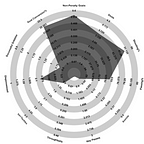On Gary Cahill and… David Justice?
With rumours flying about aplenty on Gary Cahill imminently moving to Fulham, I had a few thoughts. Aside from the majority being a lot of why’s and filled with despair about another loan signing from Chelsea — one stuck out.
It’s hard not to really compare the Cahill deal with David Justice going to the Oakland A’s in 2002.
Yes, I just made a Moneyball reference.
There are some remarkable similarities between the two deals: Justice was 35 when traded by the New York Yankees (through the Mets) to the A’s, Cahill is 33. Justice had half his salary for that year ($7 million) paid by the Yankees — it’s likely that Chelsea do the same with Cahill. Both are reaching the end of their respective great careers — Cahill won the Premier League twice with Chelsea and Justice has two rings with the Yankees. Cahill and Justice played in the biggest TV markets across the world and in the United States (London and New York).
However, there’s one big difference between the two deals: David Justice was an experiment by the Oakland A’s
Justice was acquired by Billy Beane and Paul DePodesta in December 2001 so that they could test a finding that older players were most likely to retain their ability to get “on-base” (reach first, second base, etc when they hit the baseball) as they got older and their body started to betray them. With the Yankees subsidising half of Justice’s wages (the A’s were a notably financially poor organisation in 2001) and no threat of relegation in the MLB, the A’s could afford to test their theory. (If you’re wondering, Beane and DePodesta’s theory was proved right with the Justice acquisistion — I won’t bore you with baseball stats)
There’s two issues I have with this Cahill deal:
- Fulham can’t afford to find out whether a 33 year old centre back can still play.
- They’ve done this experiment before.
Fulham are mired in a relegation battle (duh), as they were in 2014. On the final day of the window, they plucked out a 31 year old John Heitinga out of the mire in Everton and… he was relatively good! Of course, it was fairly easy to look good in that horrible team of 2013/14 with an aging Hangeland, Phil Senderos, Amorebieta and so on. Did that make the Heitinga acquisition a good one? Well, Fulham still conceded 85 goals that year, 11 more than 20th Cardiff City, so I’ll leave that up to you. Of course, there were far more issues than Heitinga to that Fulham team but it’s not as if Heitinga suddenly fixed the “Thames Barrier” overnight,
There’s also the small matter of aging in football players and accommodating this inevitable problem. Cahill is 33 — a rare age to continue playing in the Premier League now. With the league getting younger and faster seemingly every year, playing a 33 year old Cahill (who was already slow) against the likes of Salah one week and Jurgen Locadia the next doesn’t exactly fill me with confidence. You don’t need any concept of basic analytics to grasp that awful reality.
You can of course mitigate this reality by limiting his weaknesses and playing to his strengths — by playing him in the middle of a centre back trio. But is it worth taking out Alfie Mawson (upon his return from injury) for Cahill? Not in my opinion.
So, you’re left with either playing him on either side of the middle CB against faster wingers, an area where Ranieri states he wants faster defenders (which Cahill isn’t) or on the bench. In which case, you’re paying six figures a week for a bench option. You can talk about leadership, creating a culture or whatever but when you’re paying that large of a wage for a player to barely play and educate youngsters and coach the team — you might as well hire more coaches or a motivational preacher.
Fulham need defenders — there’s no doubt about that. There’s no reason why Gary Cahill should be on their wanted list of must-buys.
